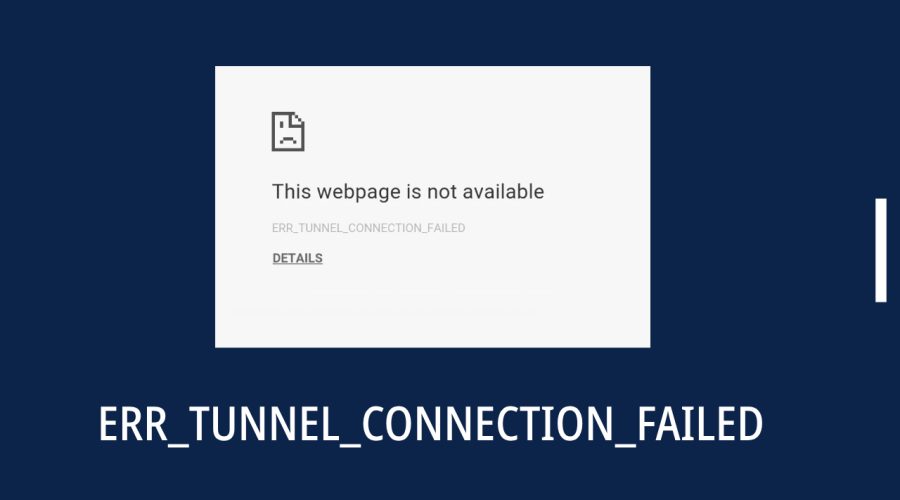Google Chrome is a popular web browser known for its speed and reliability, but like any software, it’s not immune to errors. One common error that Chrome users may encounter is “ERR_TUNNEL_CONNECTION_FAILED.” This error can be frustrating, as it prevents you from accessing websites. However, it’s essential to address it promptly. In this comprehensive guide, we will explore the causes of the ERR_TUNNEL_CONNECTION_FAILED error and provide step-by-step solutions to fix it.
Understanding ERR_TUNNEL_CONNECTION_FAILED
The ERR_TUNNEL_CONNECTION_FAILED error in Google Chrome typically occurs when there’s an issue with the browser’s proxy settings or when Chrome is unable to establish a secure tunnel connection to the web server. This error may manifest with the following message:
“Unable to connect to the proxy server ERR_TUNNEL_CONNECTION_FAILED”
Key Causes of ERR_TUNNEL_CONNECTION_FAILED
- Proxy Server Issues: Proxy servers act as intermediaries between your browser and the internet. If there are problems with your proxy settings or if the proxy server itself is misconfigured or down, you may encounter this error.
- VPN Interference: If you’re using a Virtual Private Network (VPN) service, it might interfere with Chrome’s network settings, leading to the ERR_TUNNEL_CONNECTION_FAILED error.
- Firewall Restrictions: Firewalls, either on your computer or at your network’s perimeter, can block Chrome’s tunnel connection attempts, causing the error.
- Malware or Adware: Malicious software or adware can modify your browser’s settings, including proxy configurations, leading to this error.
- DNS Issues: Domain Name System (DNS) problems can prevent Chrome from resolving the domain names of websites, resulting in the error.
Now that we’ve identified some common causes of the ERR_TUNNEL_CONNECTION_FAILED error, let’s delve into solutions to fix it.
- Check Proxy Settings
a. Open Chrome and click on the three-dot menu in the top-right corner. b. Go to “Settings.” c. Scroll down and click on “Advanced.” d. Under “System,” click on “Open your computer’s proxy settings.” e. In the “Internet Properties” window, go to the “Connections” tab. f. Click on “LAN settings.” g. Ensure that the “Automatically detect settings” option is checked and that “Use a proxy server for your LAN” is unchecked. h. Click “OK” to save your changes.
- Disable VPN Temporarily
If you’re using a VPN, try disabling it temporarily to see if it resolves the error. VPNs can sometimes interfere with Chrome’s network settings. If disabling the VPN fixes the issue, you may need to configure your VPN settings to work with Chrome.
- Check Firewall Settings
a. Open your computer’s firewall settings. b. Ensure that Chrome is allowed to access the internet. If necessary, add Chrome to your firewall’s list of trusted applications. c. Check if there are any rules or policies blocking Chrome’s network access and adjust them as needed.
- Scan for Malware and Adware
Run a full system scan using reputable antivirus and anti-malware software to detect and remove any malicious software that might be altering your browser’s settings.
- Flush DNS Cache
a. Open the Command Prompt as an administrator. b. Type the following command and press Enter:
ipconfig /flushdns - Reset Chrome
If the issue persists, you can try resetting Chrome to its default settings. Keep in mind that this will remove your browsing history, cookies, and saved passwords.
a. In Chrome, go to “Settings.” b. Scroll down and click on “Advanced.” c. Under “Reset and clean up,” click on “Restore settings to their original defaults.” d. Click “Reset settings.”
Conclusion
Encountering the ERR_TUNNEL_CONNECTION_FAILED error in Google Chrome can be frustrating, but by understanding its underlying causes and following the appropriate troubleshooting steps, you can resolve it effectively. Whether it’s an issue with your proxy settings, VPN interference, firewall restrictions, malware, or DNS problems, the solutions provided in this guide should help you get back to browsing the web without interruptions.
Remember that maintaining a secure and up-to-date browser is essential for a safe online experience. Regularly check for updates to Chrome, keep your system protected from malware, and ensure that your network settings are configured correctly to prevent such errors from occurring in the future.

Gloria Bradford is a renowned expert in the field of encryption, widely recognized for her pioneering work in safeguarding digital information and communication. With a career spanning over two decades, she has played a pivotal role in shaping the landscape of cybersecurity and data protection.
Throughout her illustrious career, Gloria has occupied key roles in both private industry and government agencies. Her expertise has been instrumental in developing state-of-the-art encryption and code signing technologies that have fortified digital fortresses against the relentless tide of cyber threats.
